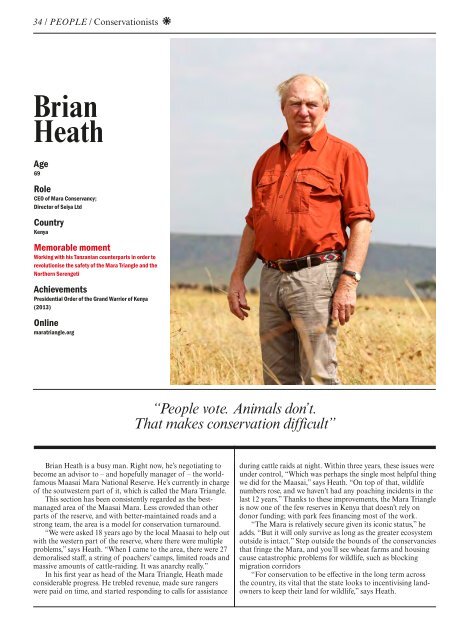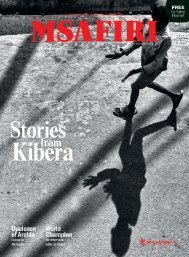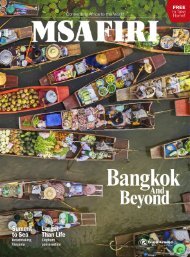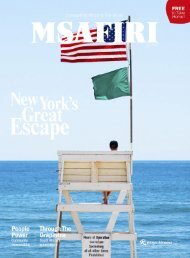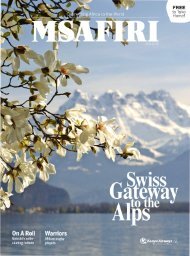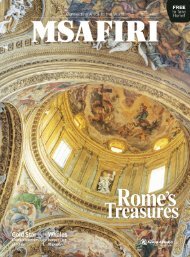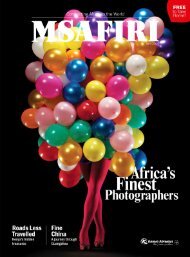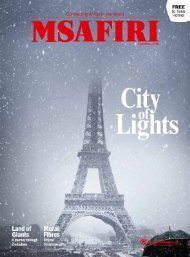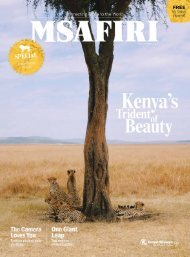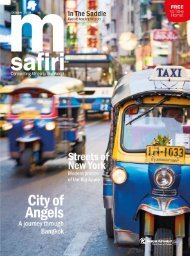You also want an ePaper? Increase the reach of your titles
YUMPU automatically turns print PDFs into web optimized ePapers that Google loves.
34 / PEOPLE / Conservationists<br />
PEOPLE / 35<br />
Brian<br />
Heath<br />
Age<br />
69<br />
Role<br />
CEO of Mara Conservancy;<br />
Director of Seiya Ltd<br />
Country<br />
Kenya<br />
Memorable moment<br />
Working with his Tanzanian counterparts in order to<br />
revolutionise the safety of the Mara Triangle and the<br />
Northern Serengeti<br />
Achievements<br />
Presidential Order of the Grand Warrior of Kenya<br />
(2013)<br />
Online<br />
maratriangle.org<br />
Thandiwe<br />
Mweetwa<br />
Age<br />
31<br />
Role<br />
Senior ecologist at the Zambian Carnivore<br />
Programme; manager of the organisation’s<br />
Conservation Education Programme<br />
Country<br />
Zambia<br />
Memorable moment<br />
Becoming a National Geographic Emerging Explorer<br />
in 2016<br />
Achievements<br />
Alumnus of the Obama Foundation’s 2018 Leaders:<br />
Africa programme<br />
Online<br />
zambiacarnivores.org<br />
Edward Selfe<br />
“People vote. Animals don’t.<br />
That makes conservation difficult”<br />
“I remember my mother’s vivid stories about the local wildlife when<br />
she was growing up; they sparked my fascination with nature”<br />
Brian Heath is a busy man. Right now, he’s negotiating to<br />
become an advisor to – and hopefully manager of – the worldfamous<br />
Maasai Mara National Reserve. He’s currently in charge<br />
of the soutwestern part of it, which is called the Mara Triangle.<br />
This section has been consistently regarded as the bestmanaged<br />
area of the Maasai Mara. Less crowded than other<br />
parts of the reserve, and with better-maintained roads and a<br />
strong team, the area is a model for conservation turnaround.<br />
“We were asked 18 years ago by the local Maasai to help out<br />
with the western part of the reserve, where there were multiple<br />
problems,” says Heath. “When I came to the area, there were 27<br />
demoralised staff, a string of poachers’ camps, limited roads and<br />
massive amounts of cattle-raiding. It was anarchy really.”<br />
In his first year as head of the Mara Triangle, Heath made<br />
considerable progress. He trebled revenue, made sure rangers<br />
were paid on time, and started responding to calls for assistance<br />
during cattle raids at night. Within three years, these issues were<br />
under control, “Which was perhaps the single most helpful thing<br />
we did for the Maasai,” says Heath. “On top of that, wildlife<br />
numbers rose, and we haven’t had any poaching incidents in the<br />
last 12 years.” Thanks to these improvements, the Mara Triangle<br />
is now one of the few reserves in Kenya that doesn’t rely on<br />
donor funding; with park fees financing most of the work.<br />
“The Mara is relatively secure given its iconic status,” he<br />
adds. “But it will only survive as long as the greater ecosystem<br />
outside is intact.” Step outside the bounds of the conservancies<br />
that fringe the Mara, and you’ll see wheat farms and housing<br />
cause catastrophic problems for wildlife, such as blocking<br />
migration corridors<br />
“For conservation to be effective in the long term across<br />
the country, its vital that the state looks to incentivising landowners<br />
to keep their land for wildlife,” says Heath.<br />
Lions are vanishing. Their numbers have halved in the last 25<br />
years, leading to the classification as vulnerable to extinction by<br />
the International Union for Conservation of Nature (IUCN).<br />
Zambia, and the Luangwa Valley in particular, is one of the<br />
last strongholds for the larger African carnivores. With roughly 40<br />
percent of the country’s land set aside for wildlife, and strong buffer<br />
zones for lion parks, these apex predators have a good chance of<br />
survival here. “Luangwa holds Zambia’s biggest lion and leopard<br />
populations and its second-largest wild dog population. So ecologically,<br />
it’s a key area,” said Thandiwe Mweetwa in an interview with<br />
BUCKiT.<br />
It is, therefore, the perfect place for research. Mweetwa, whose<br />
initial career choice of wildlife vet failed due to a fear of blood,<br />
successfully turned her attention instead to ecology and biology,<br />
and works to map the patterns of human-carnivore interaction as<br />
they shift, so she’s often tracking and studying different lion or wild<br />
dog groups. As well as rescuing snared animals, she liaises with<br />
communities whenever there are human-animal conflicts, and she<br />
runs a programme to educate youths about conservation.<br />
“We need to balance the ‘boots on the ground’ approach with<br />
meaningful engagement with disenfranchised communities,” she<br />
says. “In the next decade, we’ll be faced with the daunting task of<br />
rapid economic development coinciding with biodiversity protection.”<br />
Partly to address this, Mweetwa set up Women in Wildlife<br />
Conservation in 2016. Participants receive full instruction in all<br />
aspects of conservation work, and this vital information is integrated<br />
into secondary school- and community education.<br />
“What makes me hopeful about the work that I do, and conservation<br />
work in general, is that most of the problems are tied to<br />
human behaviour,” adds Mweetwa. “As a global community, we<br />
need to cultivate a sense of pride in our shared natural heritage,<br />
and realise that only collective effort will make a difference.”


